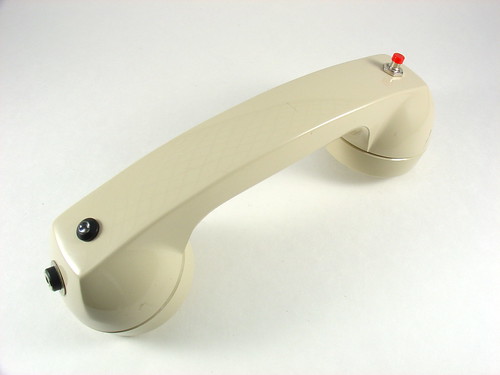
Kylie recently gave me an old, broken Motorola HS820 bluetooth headset. The headset suffered from a defective microphone that resulted in extremely low volume on outgoing audio, even though everything else worked fine.
Upon receiving it, I proceeded to rip the headset apart, interested to see what was inside. I found a fairly simple PCB with a discrete bluetooth module in the center. The PCB is not labeled, but given that this is an older headset (3-4 years old) most of the connections are large enough to attack with a pencil iron and solder wires to.
This headset was begging for a project.
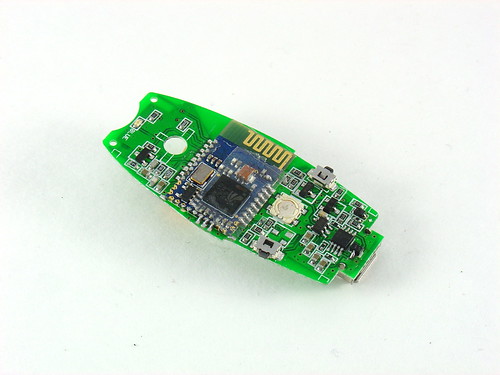
On my last trip to Weird Stuff, I came across the beauty shown below. The instant I saw it (and three other boxes full of others like it) I knew exactly what I was going to do with the broken headset: make it into a Bluetooth Handset instead.
Shown below is a vintage International Telephone & Telegraph telephone handset. ITT manufactured phones in the 60s and 70s; later they spun off that part of the business to Alcatel and then got into some trouble with the government in 2007.

The handset has some heft to it and feels great to use. It is amazing how accustomed we have become to using extremely ergonomically poor cellphones. Just compare the shape and size of a modern cellphone to a handset like this and you can understand why it is so refreshing to pick up and use one of these.
They don’t make them like this anymore. Unscrewing the faceplates reveals a speaker and a microphone which falls out onto the floor if you’re not careful. I remember phones like this when I was very young but hadn’t seen one in years.
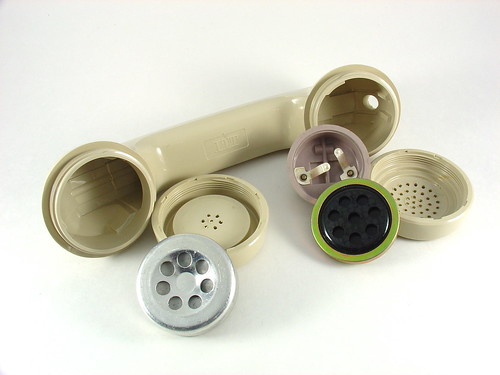
Sticking the guts of the HS820 into the handset was not that difficult or time consuming. The speaker works as-is. It turns out the impedance of the speaker that came with the bluetooth headset is around 30 ohms, while the vintage handset speaker is 42 ohms, close enough. The audio quality is excellent!
The original microphone on the HS820 was an electret, which is not the same as the carbon style on the handset. Despite this, I was able to get the microphone on the handset to work by adding a 1k series resistor and wiring it to the same terminals on the headset as the original. Without the resistor, my voice was too loud and distorted. The value took some experimentation and I may continue to play with it, or eventually give up and install a modern electret style mic instead (but the original is just too cool).
I added a pushbutton to replace the multifunction button on the headset. Holding down this button turns the handset on and off. Pushing it answers calls and probably does other stuff that I haven’t played with. The headset has volume buttons too, but the volume can be controlled via software so I didn’t wire them up to anything.
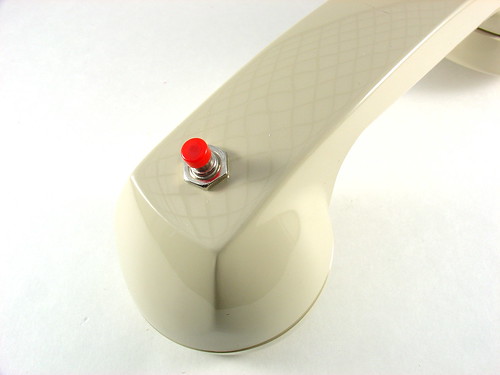
I also added a charging jack where the cord originally was. The washer is needed to fill the relatively large opening for the cord.
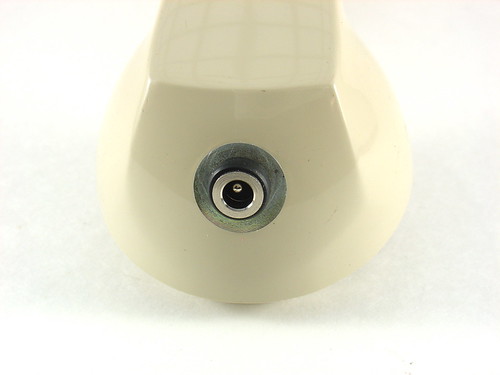
A ridiculously bright blue LED is wired in place of the status LED on the headset. I found the LED holder in my junk box.
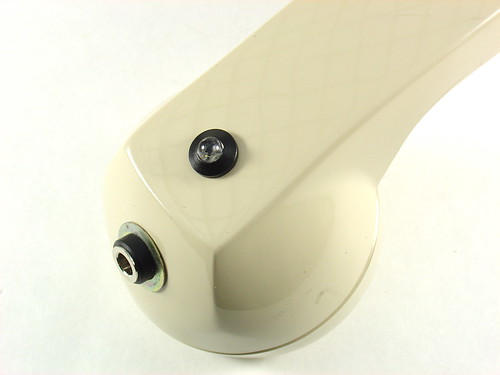
This shows the connections for the pushbutton (yellow and green wires in the center) and the LED (red and black in the bottom center). I removed the original pusbutton with my hot air rework station and soldered the new wires in place, then put a dab of hot glue on top to keep them in place. The big blue thing in the middle is the bluetooth module. I imagine that modern headsets do not have a discrete PCB for this. The HS820 PCB tucks inside the center of the handset when installed and stays in place without any special mounting.
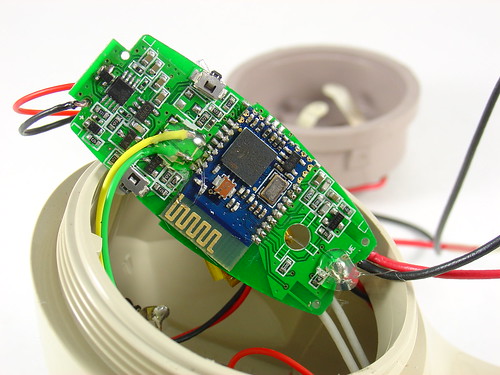
The other side of the HS820 PCB shows the 3.7V lithium battery and the connections for the microphone (lower left), speaker (lower right) and charger (upper right). The battery is glued to the PCB.
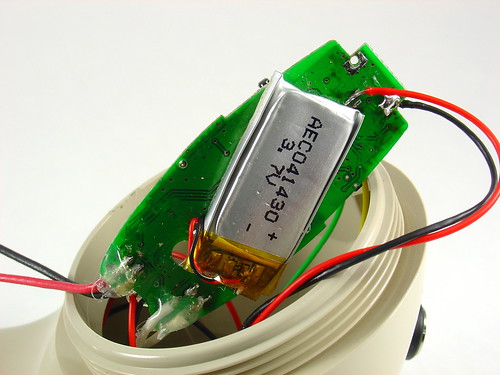
I modified the Motorola charger that came with the headset by cutting off the original 3 pin plug and replacing it with a 4.7mm power connector to match the jack on the phone. The third pin of the original connector wasn’t being used anyway.
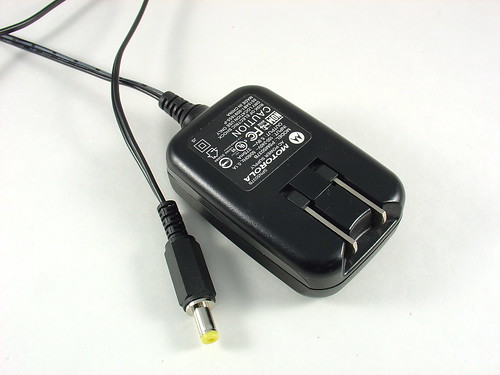
To charge the handset, you just plug in the charger. The LED lights up to show that the handset is charging and goes out when it’s done. It flashes during normal use, blinding spectators.
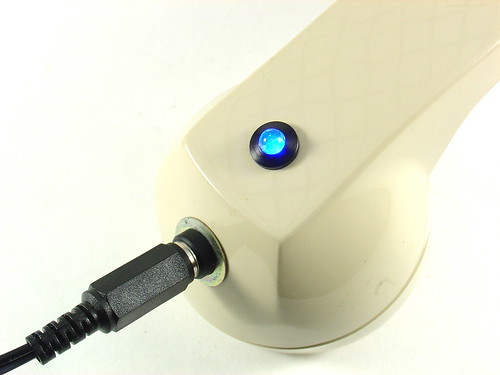
I’m planning to use this for Skype on my desktop computer, but I may just have to carry it around for a few days to see what other people think of it…
Update: As mentioned in the comments, these are for sale at ThinkGeek.com, search for “retro handset”.
Update 2 (11/20/09): Welcome, Make: readers! Questions about this project? Head over to the forums for help!


please tell me!!! you think I can connect a charger direct to cables +, – and works without battery?????
You can try this, but I don’t think it will work. You will most likely damage the headset because it is not designed to accept the charger voltage on the battery leads.
Jeff,
I just found this post during a search for this exact kind of thing. Really cool. I know that ThinkGeek sells one of these but I’d like to do it with an older phone so I get a nice heavy handset. Question – I have know electronic experience; do you think I can do something like this? I’m technically inclined and am a research scientist (molecular biology) so I think I can learn. I’m just a little concerned about the technical skills – soldering, etc. What do you think? I’m also interested in repurposing the original coiled cord as the charging line. My idea is to use the telephone base as a charging station. Do you think that’s possible?
thanks.
Thanks for the reply. I managed to improve the sound…I just swapped out for a newer speaker. What gauge of wire are you using, btw? Solid or stranded?
Thanks,
~mark
Stranded, somewhere around 24-30 gauge if I remember correctly. I think most of the wire was stuff I reused from another project.
I tried this with a really old handset and a samsung bluetooth. I used the original speaker and it was really quiet. The impedance on the handset and headset speakers were pretty close. What can I do to boost the volume (I also turned the volume to maximum).
Thanks,
~mark
Mark –
I’m not sure why the volume is low, it could be due to differences in the speakers found in old handsets or the audio drive capability of different bluetooth headsets.
I would start by double checking your wiring and solder connections, just to be sure a hairline short isn’t killing the audio signal. If everything looks ok, you could try a different speaker from another brand of handset to see if one type works better than another. Alternatively, you could scrounge the original speaker out of the bluetooth headset and glue it to the back of the earpiece – kind of a hack but a good backup plan. Even the tiny 8 ohm speaker out of a small electronic toy or greeting card should work.
Another option – If you are comfortable with building simple electronics, you could build a small audio amplifier using an LM386 chip (see Make’s cracker box guitar amp) and power it with the headset battery, assuming the 386 can go that low in voltage.
Hope this helps,
Jeff
It is, as you guessed:
A back to back diodes that protect the person using the phone from strikes or other high voltage on the line.
Hi Dana!
Someone actually did something very similar to what you are looking for, check this out:
http://www.vonslatt.com/proj-handset.shtml
That should give you a head start!
hey,
nice work! i’m interested in modifying an old handset like this to connect to a cellphone (motorola razr) with the original squiggly wire. as far as you know, is there any way this could be done (some kind of adaptor, or something)? i know they make reproduction vintage handsets, but i want an *actual* vintage handset. the weight and sound can’t be duplicated! feel free to email me – thanks a lot!
That is a great idea. There certainly is room!
Just to let you know, you could replace the relatively tiny battery with any LiPo battery that you can find in other electronics for much, much more runtime.
I took a pack apart from a model airplane that had one cell starting to go bad (swell up) and I now get over 8 hours of talktime in a very similar setup to yours.
ThinkGeek sells a similar thing— for $30! Nice job!
http://www.thinkgeek.com/electronics/cell-phone/8928/
you should definitely sell these, or sell kits w/diagrams. i know i’d buy one!! all you need now is one of those secretary shoulder-crutches and it’s hands-free!!
It’s the “Old Phone” ringtone that comes with the iPhone.
Where did you get the ringtone? I’ve been hunting everywhere but so far none of them sound right. That one is perfect!
Tony – I used a multimeter. It’s not the AC impedance but for this it doesn’t really matter, I just needed to make sure they were in the same ballpark.
Mark – It’s a ringtone. 🙂
Um, if you want to make me a birthday present…
Where’s the ringer? Or is that a ringtone?
how did you determine the speaker impedance?